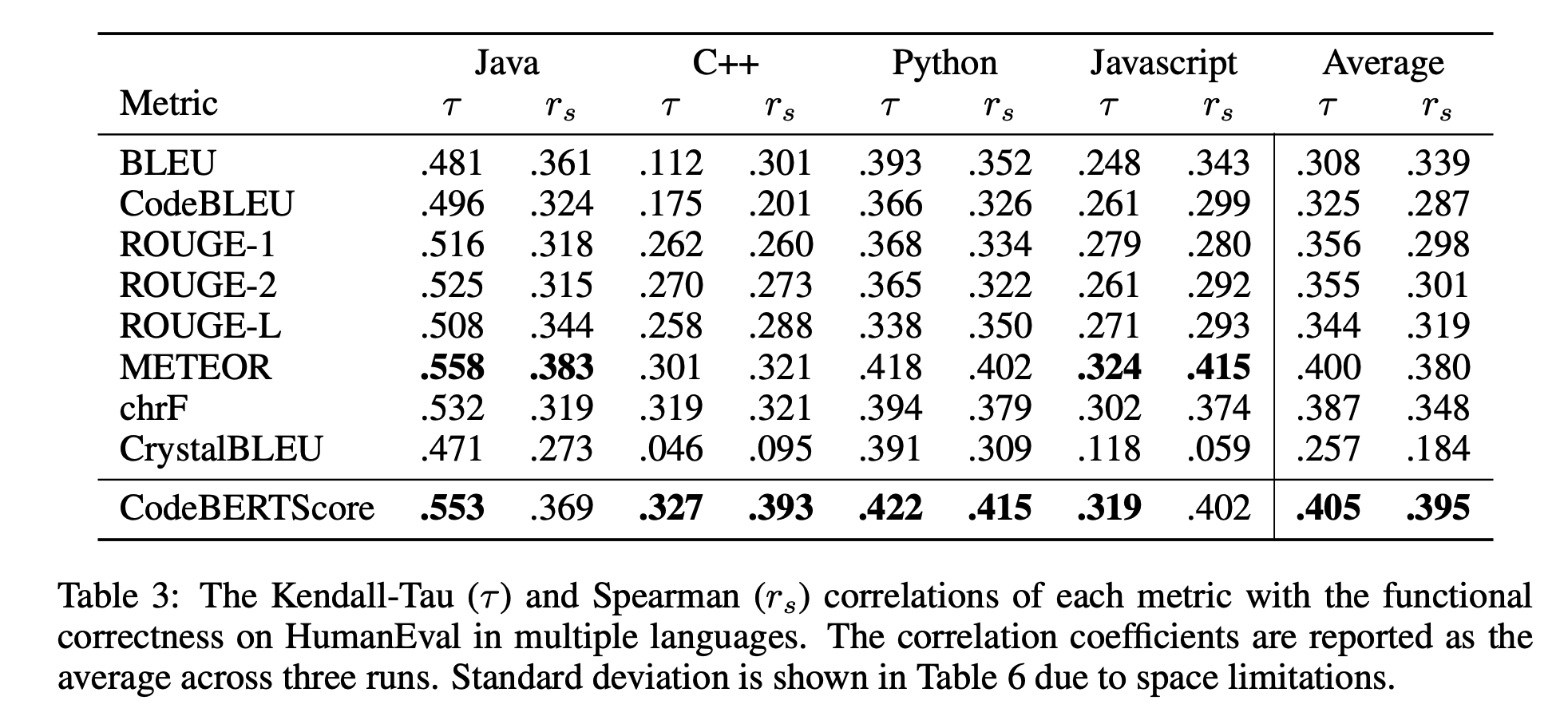This is the official implementation of the paper:
Shuyan Zhou, Uri Alon, Sumit Agarwal, Graham Neubig, CodeBERTScore: Evaluating Code Generation with Pretrained Models of Code
CodeBERTScore is an Automatic Evaluation Metric for Code, based on BERTScore. This repository is based on the code of BERTScore, and we are grateful to the authors for releasing their code.
April 2023 - CodeBERTScore is now available on pypi, which means that you can simply pip install code-bert-score!
Figure (a) shows a reference code snippet in Java. Figures (b) and (c) show two generated predictions. Among these two candidates and given the reference, BLEU prefers (scores higher) the code in (b), which is not functionally equivalent to the reference, while CodeBERTScore prefers the code in (c), which is functionaly equivalent to the reference.
As BERTScore, CodeBERTScore leverages the pre-trained contextual embeddings from a model such as CodeBERT and matches words in candidate and reference sentences by cosine similarity. Differently from BERTScore, CodeBERTScore also encodes natural language input or other context along with the generated code, but does not use that context to compute cosine similarities.
This example shows how CodeBERTScore can compute the similarity between the Python expressions x ** 0.5 and math.sqrt(x), which are functionally equivalent, even though they have very few overlapping tokens.
import code_bert_score
pred_results = code_bert_score.score(cands=predictions, refs=refs, lang='python')
Where pred_results is a 4-tuple of (precision, recall, F1, F3), where each is a 1-D tensor of scores for each prediction-reference pair. F3 is similar to the well-known F1 score, that considers recall 3 times as important as precision. See the definition on Wikipedia.
See our example.py script. Additional details are shown in the original BERTScore demo notebook.
We fine-tuned the microsoft/codebert-base-mlm model for 1,000,000 steps (with batch_size=32) on several languages separately.
We released the following models to the Huggingface hub:
neulab/codebert-python(the default model forlang='python')neulab/codebert-javascript(the default model forlang='javascript'or'js')neulab/codebert-c(the default model forlang='c')neulab/codebert-cpp(the default model forlang='cpp'or'c++')neulab/codebert-java(the default model forlang='java')
The appropriate model will be loaded automatically when passing the lang argument to the score(..) function, for example: lang='python'.
For other uses, these models can be loaded using (for example):
from transformers import AutoTokenizer, AutoModelForMaskedLM
tokenizer = AutoTokenizer.from_pretrained("neulab/codebert-python")
model = AutoModelForMaskedLM.from_pretrained("neulab/codebert-python")- We found that in NL->Code problems, more accurate results are achieved by encoding the NL
sourceswith the code prediction, but then measuring similarity only for the encoded code:
pred_results = code_bert_score.score(cands=predictions, refs=refs, lang='python', sources=sources)
-
We also found that using Inverse Document Frequencies improve the results, similarly to the original BERTScore. We included an example script that shows how to precompute them here compute_idf.py. Then, the resulting dictionary can be used with the argument
idf=idf_dict. Our IDF dicts can be found in ./idf_dicts/. -
Tuning the layer that the similarity is computed from is also helpful, using
num_layers=NwhereNis between 5-10:
- We found that more accurate results are achieved by encoding the entire inputs, but measures the similarity only between non-punctuation and non-whitespace tokens. To disable the removal of punctuation tokens, use
no_punc=False.
See also our example.py script. Additional details are shown in the original BERTScore demo notebook.
The run_mlm.py script can be used to fine-tune the base model microsoft/codebert-base-mlm on specific languages.
The code to reproduce the results in the paper can be found in the evaluation.
We find that CodeBERTScore is more correlated with human preference compared to a variety of common metrics. See more details in the paper.
We find that CodeBERTScore is more correlated with functional correctness compared to a variety of common metrics. See more details in the paper.
@article{zhou2023codebertscore,
url = {https://arxiv.org/abs/2302.05527},
author = {Zhou, Shuyan and Alon, Uri and Agarwal, Sumit and Neubig, Graham},
title = {CodeBERTScore: Evaluating Code Generation with Pretrained Models of Code},
publisher = {arXiv},
year = {2023},
}




